Related Research Articles
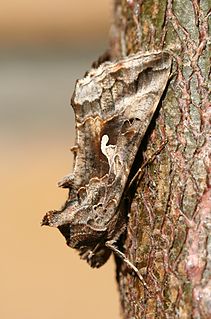
Plusiinae is a smallish subfamily of the moth family Noctuidae. As the Noctuidae appear to be a paraphyletic assemblage, the Plusiinae may eventually be raised to family status.

Chrysodeixis eriosoma, the green garden looper, is a moth of the family Noctuidae. Mostly cosmopolitan distribution, it is a serious pest found throughout Wadelai, Aden, Japan, China, throughout the Indian, Sri Lanka, Malayan, and Australasian regions. It is present in Hawaii and recorded as an incursion in mainland North America and Russia. It is morphologically identical to Chrysodeixis chalcites and the two may be sibling species.
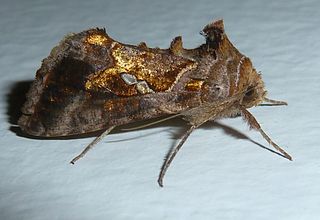
The Tomato Looper or golden twin-spot moth(Chrysodeixis chalcites) is a moth of the family Noctuidae, subfamily Plusiinae. It is found from southern Europe, the Levant and tropical Africa, but can be found in great parts of Europe because it is a migratory species. It has also recently been reported from North America.
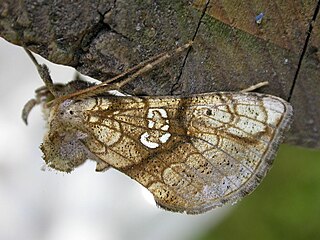
Polychrysia is a genus of moths of the family Noctuidae. More commonly known as owlet moths.

Autographa ampla, the large looper moth, raspberry looper, brown-patched looper or broken-banded Y, is a moth of the family Noctuidae. The species was first described by Francis Walker in 1858. It is found in North America from Newfoundland west to the Alaska panhandle, south to central California, Arizona and New Mexico in the west and North Carolina in the east.

Rachiplusia ou, the gray looper moth, is a moth of the family Noctuidae. The species was first described by Achille Guenée in 1852. It is found in the southern and eastern parts of the United States, Montana, Nova Scotia, from Mexico to Venezuela to Ecuador and the Dominican Republic.

Enigmogramma basigera, the pink-washed looper, is a moth of the family Noctuidae. The species was first described by Francis Walker in 1865. It is found in the eastern and central United States, south to Mexico. It is also found in the Caribbean, south to French Guiana.
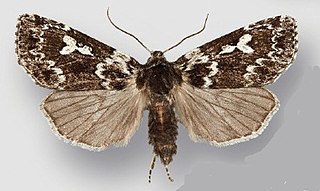
Xestia perquiritata, the boomerang dart, is a moth of the family Noctuidae. The species was first described by Herbert Knowles Morrison in 1874. It is found across North America from Newfoundland, Labrador and northern New England, west to central Yukon, British Columbia and Washington. There are several disjunct populations, including one in the Great Smoky Mountains National Park and the Rocky Mountains in Colorado and a coastal bog in central Oregon.
Abrostola ovalis, the oval abrostola, is a moth of the family Noctuidae. The species was first described by Achille Guenée in 1852. It is found in north-eastern North America from southern Quebec and Maine south to North Carolina and west to Wisconsin.

Allagrapha aerea, the unspotted looper moth or copper looper moth, is a moth of the family Noctuidae. The species was first described by Jacob Hübner in 1803. It is found in eastern North America from southern Ontario to the Florida Panhandle and west to western Nebraska.
Diachrysia aereoides, the dark-spotted looper or lined copper looper, is a moth of the family Noctuidae. The species was first described by Augustus Radcliffe Grote in 1864. It is found in North America from Newfoundland west to northern California. It reaches its southernmost distribution in Great Smoky Mountains National Park.

Diachrysia balluca, the green-patched looper, is a moth of the family Noctuidae. The species was first described by Carl Geyer in 1832. It is found in north-eastern North America from Nova Scotia west to Manitoba and south to western North Carolina. Great Smoky Mountains National Park is the southern limit of this species. The only other records in the south are from the type locality of Georgia and a record from Liberty County in north-western Florida. These possibly represent strays.
Chrysanympha formosa, the Formosa looper, is a moth of the family Noctuidae. The species was first described by Augustus Radcliffe Grote in 1865. It is found in North America from Newfoundland west to Manitoba and south to the mountains of North Carolina and Tennessee.
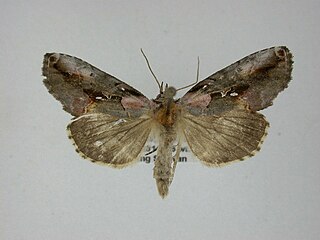
Eosphoropteryx thyatyroides, the pink-patched looper moth or pink-tinted beauty, is a moth of the family Noctuidae. The species was first described by Achille Guenée in 1852. In North America it is found from Nova Scotia and northern Ontario south to Minnesota, Michigan, Ohio and along the Appalachians from Maine to eastern Tennessee and western North Carolina; and to the west, it occurs from central Alberta and southern British Columbia, south in the Cascades to southern Oregon, and in the Rocky Mountains to northern Idaho.
Heliothis oregonica, the Oregon gem, is a moth of the family Noctuidae. The species was first described by Henry Edwards in 1875. It is found in North America from the Peace River area of Alberta south and west in the mountains to California and Arizona. There is also a disjunct population in north central Quebec.
Diarsia calgary, the Calgary dart, is a moth of the family Noctuidae. The species was first described by Smith in 1898. It is found in North America in the mountains and foothills from Yukon, south to Arizona and New Mexico, west to the coast of British Columbia. There is a disjunct population in central western California.
Lasionycta subdita is a moth of the family Noctuidae. It is a subarctic species and is found across Labrador, Quebec and Ontario to Churchill, Manitoba on the west shore of the Hudson Bay. A disjunct population is found in the White Mountains of New Hampshire.
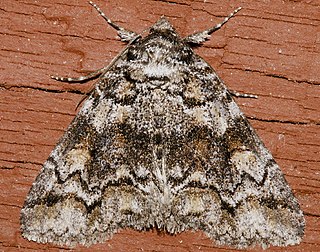
Zale duplicata, the pine false looper zale, pine false looper, banded similar-wing or grey similar-wing, is a moth of the family Noctuidae. The species was first described by Charles J. S. Bethune in 1865. It is found in woodlands and forests from British Columbia to Nova Scotia, south to the mountains of Georgia and Texas.

Panchrysia aurea is a moth of the family Noctuidae. It is found in southern Europe and western and central Asia. The range extends from Portugal, east to Tian Shan, the Altai and the north-western Himalayas. In central Europa, it is found in the southern Alps, lower Austria and the mountains on the Balkan Peninsula.
Polychrysia esmeralda, the delphinium leaftier, is a moth of the family Noctuidae. The species was originally described by Charles Oberthür in 1880. It is found in Asia and in North America. The larvae feed on monkshood and larkspur or delphinium. Adults are reported to feed on the nectar of fireweed.
References
- ↑ "931183.00 – 8902 – Polychrysia morigera (Edwards, 1886)". North American Moth Photographers Group. Mississippi State University. Retrieved December 12, 2020.
- "Polychrysia morigera - (Hy. Edwards, 1886); The Disjunct Looper". Pacific Northwest Moths. Archived from the original on June 24, 2010.
- Pogue, Michael G. (2005). "The Plusiinae (Lepidoptera: Noctuidae) of Great Smoky Mountains National Park" (PDF). Zootaxa . 1032: 1–28.
| This Plusiinae-related article is a stub. You can help Wikipedia by expanding it. |